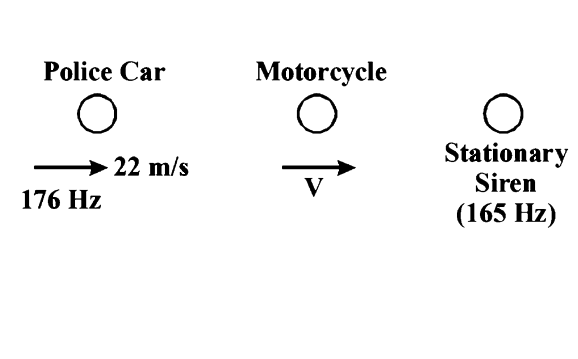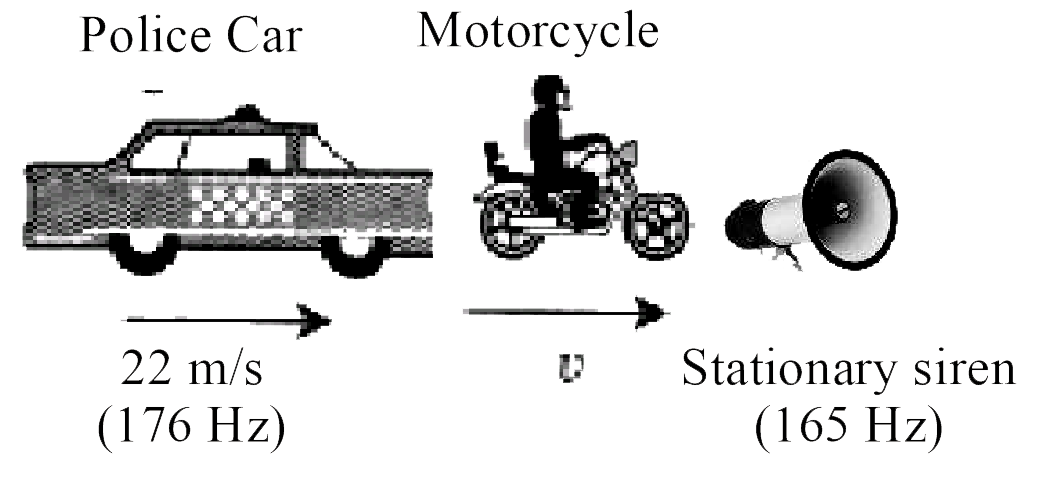A police in a siren car moving with a velocity 20ms−1 chases a thief who is moving in a car with a velocity v0ms−1.The police car sounds at frequency 300 Hz, and both of them move towards a stationary siren of frequency 400 Hz. Calculate the speed in which thief is moving. Solution in Tamil
Velocity of sound v= 330ms−1
Velocity of car (vs)=20ms−1
Frequency of car (f1)=300 Hz
Frequency of stationary siren (f2)= 400 Hz
The speed of the thief (vo)=?
v1=f1[v−vov−vs] and v2=f2[v+vov]
Both are moving towards stationary siren v1=v2
300[300−vo310]=400[300+vo330]
330−vo=4×3103[330+vo330]
330−vo=1240990[330+vo]=1.2525(300+v0)
330−vo=413.325+1.2525vo
2.2525vo=−83.325
vo=−36.99
∴ Speed of the thief in moving = 36.99ms−1
Topper's Solved these Questions
- BOOK - FULL MARKSCHAPTER - WAVES EXERCISE - Textual Evaluation Solved (Conceptual Questions )6videos
WAVES
- BOOK - FULL MARKSCHAPTER - WAVES EXERCISE - Additional Questions Solved87videos
WAVES
- BOOK - FULL MARKSCHAPTER - WAVES EXERCISE - Textual Evaluation Solved (Long Answer Questions )16videos
WAVES
- BOOK - FULL MARKSCHAPTER - SOLVED PAPER 17 (UNSOLVED)EXERCISE - Part-IV10videos
SOLVED PAPER 17 (UNSOLVED)
- BOOK - FULL MARKSCHAPTER - WORK, ENERGY AND POWEREXERCISE - Additional Question Solved (Numercials)11videos
WORK, ENERGY AND POWER
Similar Questions
Why is it that transverse waves cannot be produced in a gas? Can the transverse waves be produced in solids and liquids?
07:59View SolutionExplain the types of mechanical wave.
02:54View SolutionDiscuss how ripples are formed in still water.
02:54View SolutionIn a series of successive measurements in an experiment, the readings of the period of oscillation of a simple pendulum were found to be 2.63s, 2.56s, 2.42, 2.71s and 2.80 s. Calculate
(i) the mean value of the period of oscillation
(ii) the absolute error in eah measurement
(iii) The men absolute error (iv) the relative error (v) the percentage error. Expresss the results in proper form.View SolutionA body is moving along z-axis of a coordinate system under the effect of a constant force F=(2→i+3ˆj+vˆk)N. Find the work done by the force in moving the body a distance of 2 m along z-axis
View SolutionA police car moving at 22m/s, chases motorcyclist. The police man sounds his horn at 176Hz, while both of them move towards a ststionary siren of frequency 165Hz. Calculate the speed of the motorcycle, if it is given that he does not observes any beats.
 05:27View Solution
05:27View SolutionA police car moving at 22m//s , chases a motorcyclist, the police man sounds his horn at 176 Hz , while both of them move towards a stationary siren of frequency 165 H z. Calculate the speed of the motorcycle, if it is given that he does not observes any beat
07:01View SolutionA police car moving at 22 m/s, chases a motorcylist. The police man sounds his horn at 176 Hz, while both of them move towards a stationary siren of frequency 165 Hz. Calculate the speed of the motorcycle, if it is given that he does not observes any beats
 View Solution
View SolutionA police in a siren car moving with a velocity 20ms−1 chases a thief who is moving in a car with a velocity v0ms−1. The police car sounds at frequency 300 Hz, and both of them move towards a stationary siren of frequency 400 Hz. Calculate the speed in which thief is moving. (Assume the thief does not observe any beat).
05:10View SolutionA police in a siren car moving with a velocity 20 ms^(-1) chases a thief who is moving in a car with a velocity v_(0)ms^(-1) .The police car sounds at frequency 300 Hz, and both of them move towards a stationary siren of frequency 400 Hz. Calculate the speed in which thief is moving.
View SolutionA police in a siren car moving with a velocity 20ms−1 chases a thief who is moving in a car with a velocity v0ms−1.The police car sounds at frequency 300 Hz, and both of them move towards a stationary siren of frequency 400 Hz. Calculate the speed in which thief is moving.
View SolutionA police car moving at 30 m s−1, chases a motorcyclist. The policeman sounds his horn at 180 Hz, while both of them move towards a stationary siren of frequency 160 HZ. He does not observe any beats then, calculate the speed (in m s−1) of the motorcyclist round off two decimal places? [speed of sound =330ms−1]
02:54View SolutionA police caar moving at 22 m . s−1 chases a motor cycle . The man in the car sounds his horn at 170 Hz while both of them move towards a stationary siren of frequency 165 Hz . Calculate the speed of motor cycle if the motor cyclist does not listen any beat .
02:09View SolutionA police car moving at 22ms−1 chases a motor cyclist. The police man sounds horn at 176 Hz. While both of them move towards a stationary siren of frequency 165 Hz. If the number of beats heard by the motor cyclist per second is zero, then the speed of motorcycle is (Speed of sound in air =330ms−1)
03:53View SolutionA police car moving at 22m/s chases a motorcyclist. The police man sounds his horn at 176 Hz, while both of them move towards a stationary siren of frequency 165 Hz. Calculate the speed of the motorcycle. If it is given that the motorcyclist does not observe any beats:
02:27View Solution

